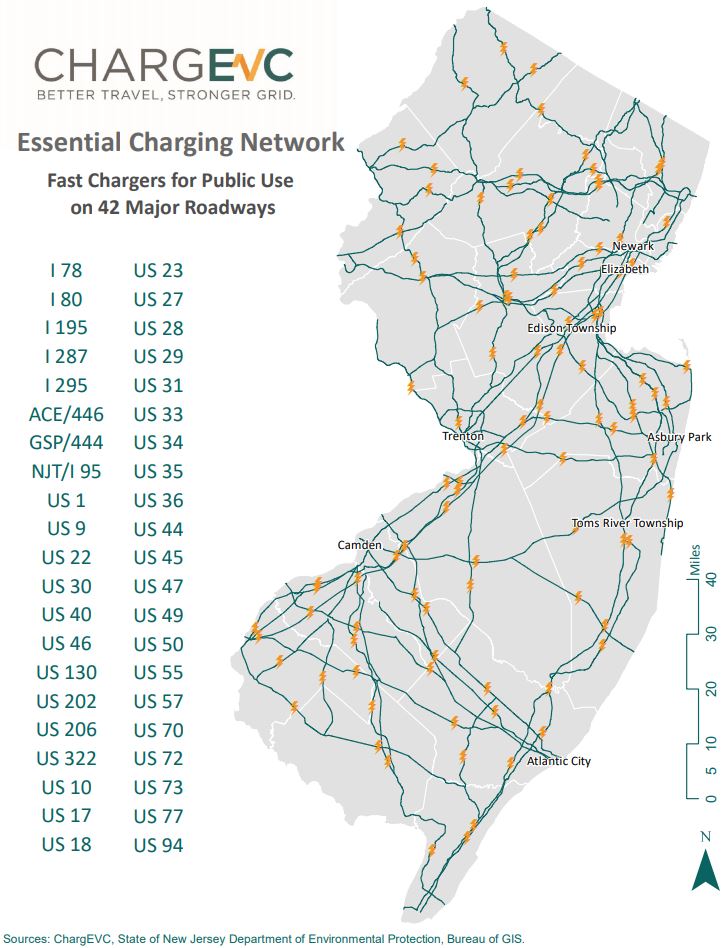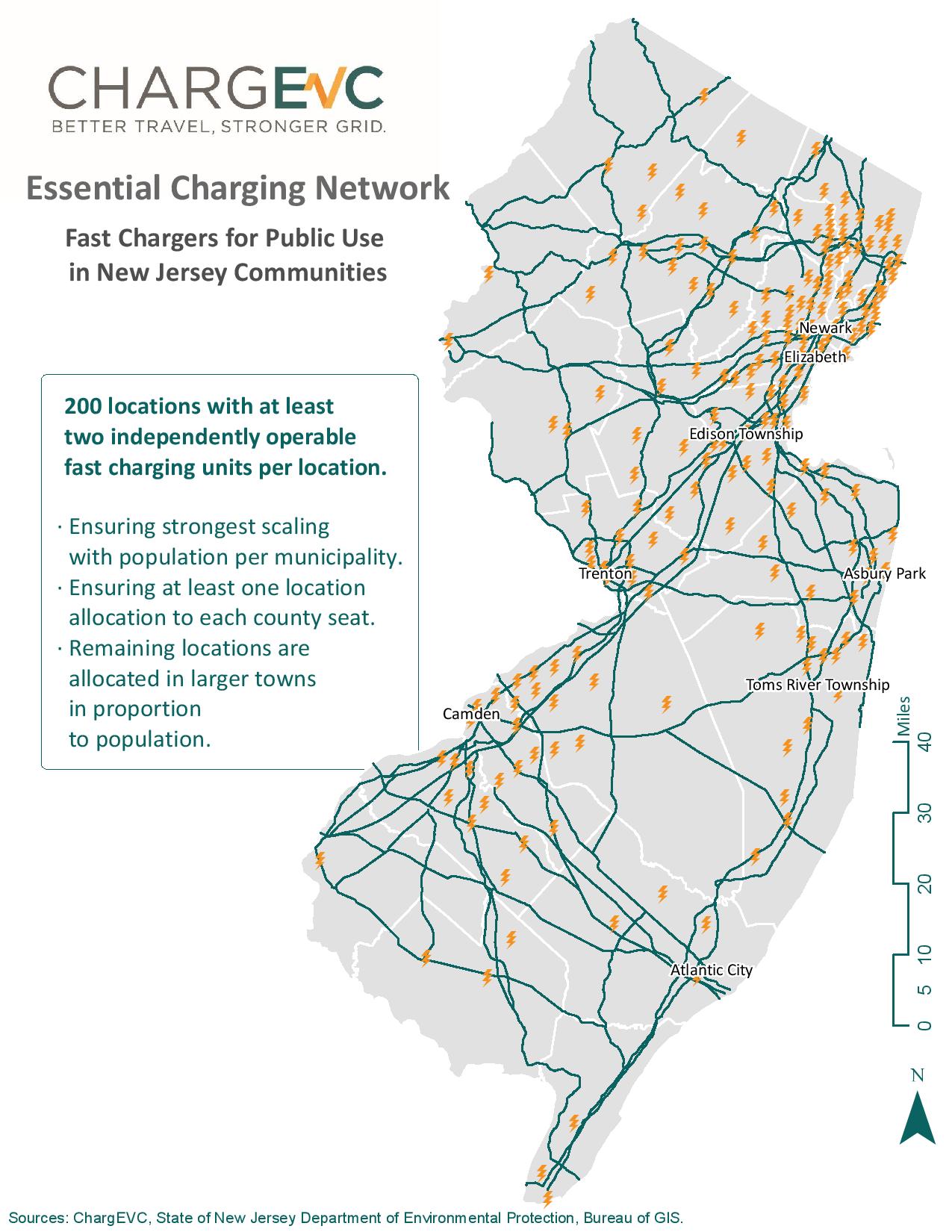Public Fast Charging Initiative in New Jersey
The Essential Public Charging Network (EPCN) is a comprehensive statewide initiative that will advance New Jersey to the forefront of addressing one of the most critical barriers to Electric Vehicle (EV) adoption: Range Anxiety, which is the concern by potential EV drivers that there are not enough public chargers available to avoid the risk of being stranded.
What Is The EPCN?
The EPCN will jumpstart the market by providing a critical mass of high power fast charging facilities for public use. The EPCN will provide sufficient geographic coverage to ensure that most EV drivers will have convenient access to a quick charge while on major New Jersey roadways or in the town where they live or work. The EPCN is not intended to provide all the public fast charging facilities that will eventually be required as the EV market matures, but to address critical unmet needs of the early market, stimulate accelerated EV adoption, and seed the market for long term growth. The focus is on the essential level of service required to adequately and equitably address the range anxiety concerns of potential EV buyers. As a result of EPCN development, most drivers will naturally pass a quick charge facility as part of their daily routine, similar to the confidence and convenience they enjoy with fueling a traditional vehicle. The EPCN solution is proposed as a joint effort of the New Jersey electric utilities and the competitive market, and will meet the needs of both long-distance and local New Jersey drivers. The EPCN is possible because of rapid advances in DC Fast Charging (DCFC) technology: it is now possible to charge even large EV batteries to 80% of full-charge within 20 minutes or less. In summary, the EPCN is intended to eliminate range anxiety concerns for EV drivers in the state of New Jersey.

Why Is The EPCN Needed?
Most EV drivers will charge their vehicle at home overnight, and will start each day with a “full battery” that is able to fully support their routine travel pattern. Charging away from home, for most drivers, will be rare. However, consumers are extremely sensitive to the exception conditions that may require charging away from home, including long distance travel, and situations where they are forced outside their typical routine (unexpected trips, emergency situations, etc.). Most mainstream consumers will not be comfortable transitioning to an EV until there is sufficient public charging infrastructure to ensure that these rare but important “en-route” charges can be realized quickly and conveniently. Publicly accessible quick charging facilities are an effective way to meet this key consumer requirement. To address the concerns of potential EV buyers, however, those facilities need to be available before widespread adoption can begin.
The early stage EV market in New Jersey is not naturally developing the extent public charging infrastructure required, as evidenced by the simple fact that a perceived lack of public quick charge facilities (i.e. range anxiety) remains one of the top consumer adoption concerns. This public perception is backed up by empirical fact: New Jersey has approximately 22% the penetration of public chargers per capita as the five states leading in PEV adoption (YE 2016), and many of these public chargers are not generally usable by all drivers due to technical and commercial constraints.
Given that the infrastructure must be built before consumers will adopt, utilization for these early-stage facilities when there are few EVs on the road is very low. That makes DCFC economics extremely difficult initially, limiting private investment and restraining the infrastructure development needed. These are structural conditions inherent in early market conditions that can be overcome through a comprehensive statewide initiative. The EPCN is intended to provide the critical mass of infrastructure needed to transition the market through this early phase of limited pubic fast charging infrastructure development and jump start the higher levels of EV adoption that lead to long term growth.
Note: The following maps illustrate the potential coverage provided by an essential high power public charging network proposed by ChargEVC for the state of New Jersey. New Jersey has a unique opportunity given its size and development density. As such, a relatively small number of locations can ensure convenient access by most EV drivers. The corridor locations achieve a basic geographic density based on where both long distance and local drivers travel. The community locations provide charging opportunities where most New Jersey residents live or work. Please note that this map is illustrative only, and is not intended to specify specific locations for development.

The NJ Opportunity
The EPCN takes advantage of unique conditions in New Jersey that make development of the EPCN highly feasible. Due to the state’s relatively compact travel infrastructure and travel patterns, a relatively small number of publicly accessible facilities can serve the majority of drivers conveniently. Larger state and federal roads support ~67% of the miles traveled in New Jersey every day, and so sufficient DCFC coverage of those roadways provides essential charging services for the majority of drivers and daily trips – for both long distance and local drivers. Similarly, approximately 75% of NJ residents live in about one-third of New Jersey towns, so a relatively small number of community locations will provide essential charging services to most drivers near where they live or work.
Based on analysis done by Gabel Associates for ChargEVC, a critical mass of essential charging services can be achieved for New Jersey with 100 locations along high-travel roadways with a design goal of no more than 25 miles between corridor locations, combined with 200 locations in community centers. The 25-mile location density is intended to ensure convenient access by local New Jersey drivers during their natural driving pattern – with the EPCN in place, a quick charge will be “on the way” for most EV drivers. See maps that illustrate the coverage proposed by the EPCN initiative, based on allocating corridor locations where drivers travel, and community locations near population centers. Each location is expected to support two to four independently operable DCFC units (depending on expected utilization), but at least two to ensure redundant facilities at each location. As noted above, this minimum critical mass is not the full level of public charging service needed at full market maturity. Instead, it represents the critical mass of infrastructure needed to overcome natural barriers that are limiting market development today, eliminate the concern by potential EV buyers regarding public charging availability, and jump start the market to ensure long term growth. With this foundation in place, the competitive market can continue to deploy additional infrastructure as demonstrated by evolving market need. The EPCN is a bold and innovative initiative that will create leadership market conditions for widespread EV adoption by mainstream consumers in New Jersey.

